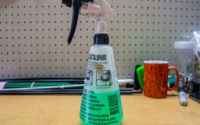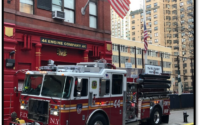The NFPA Hazmat Response Standard: Facts, Myths and Legends
Rick Edinger, EFO
The National Fire Protection Association (NFPA) has been around since the late 1800s and manages over 200 codes and standards. While these documents affect everything from electrical work to building codes to fire and hazmat training, many people don’t understand how NFPA codes and standards are maintained or how to participate in the standards making process. Let’s look at some facts, myths and legends specific to the NFPA codes and standards making process.

Fact: The NFPA Hazardous Materials/WMD Response Technical Committee is responsible for NFPA 470, Hazardous Materials/Weapons of Mass Destruction (WMD) Standard for Responders. The committee also maintains NFPA 475, Recommended Practice for Organizing, Managing, and Sustaining a Hazardous Materials/Weapons of Mass Destruction Response Program.
Fact: The NFPA hazmat standards underwent a consolidation process during the last revision cycle. The former NFPA 472 (training competencies), NFPA 1072 (Pro qual JPR training language) and NFPA 472 (EMS for hazmat) were all consolidated into NFPA 470 as of 2022. NFPA 475 which is a recommended practice (“should” versus “shall”) remains a standalone document.
Myth: NFPA 470 dictates how to respond to a hazmat incident. False – NFPA 470 is not a response standard. This standard (using “shall” language) provides guidance on the training of hazardous materials responders. It is one of the few NFPA standards that provides both competency-based language as well as satisfying the professional qualifications community (ex. Pro Board) need for language written in job performance requirements (JPR) style. The committee strives to not be prescriptive in how to respond to a hazmat incident but rather provide guidance on the training needed to be proficient, safe and effective at various levels of hazmat responder competencies.
Fact: NFPA 470 is a minimum performance, voluntary consensus standard. It does not carry the weight of law or regulation unless adopted by reference by a political body or is mandated by an authority having jurisdiction (AHJ). Roughly half of the United States and all the Department of Defense (DoD) use professional qualification (Pro Qual) standards for certifying emergency responders. This means hazmat responders in these geographic areas and organizations are mandated to train, test and certify using the JPRs in NFPA 470.
Myth: NFPA 470 does not supersede OSHA 1910.120, aka the federal Hazwoper regulations. OSHA regulations carry the weight of law where NFPA standards do not, unless adopted by an AHJ with authority to mandate adherence to local, state or regional requirements. Whereas OSHA 1910.120 was last updated many years ago, the NFPA hazmat standard (470) and recommended practice (475) are revised every five years to allow the documents to remain timely and relevant to our response environment. Proficiency with the training competencies in NFPA 470 meet and often exceed those listed on OSHA 1910.120(q).
Legend: The NFPA Hazmat Response Committee was chaired for more than a decade by Chief John Eversole from the Chicago Fire Department. Chief Eversole is credited with bringing hazmat response to the forefront of emergency services awareness by advocating for better training and funding for hazmat response programs. Chief Eversole also simultaneously chaired the International Association of Fire Chiefs (IAFC) Hazmat Committee, the only person to chair both committees.


Myth: The public has no say in what is included in NFPA codes and standards. This is inaccurate as all NFPA committees adhere to a strict process in developing and maintaining these documents. Included in this process are two transparent public input opportunities in which anyone can comment on the existing standard language and make suggestions for changes. Each one of these public inputs must be reviewed and acted upon by the committee. The results of each review are provided to the submitter and made available to the public via periodic reports during the document revision cycle.
Legends: The current NFPA Hazmat Response Committee has two plank holder members from the original committee, which formed in 1986. Charlie Wright, retired from Union Pacific Railroad, is a Member Emeritus and remains one of our go-to members for document review. Greg Noll, who succeeded John Eversole has chairman and served for 10 years in that role, remains an active member of the committee. Both provide a wealth of insight and history which serves to guide the committee in all activities.
Fact: NFPA committees are made up of volunteers. The NFPA carefully screens applicants and appoints members to committees based on qualifications and the need to maintain a balanced group of members so that no one constituency or interest group may sway votes on document content. The NFPA Hazmat Response Committee is the second largest NFPA standards committee by numbers and is made up of a broad cross-section of hazmat professionals from public safety, industry, military, trainers and other interested parties (ex. book publishers). The size and make up of our committee ensures that we have a broad and diverse group of people who understand hazmat training and program management and recognize the needs of our responder community.

Myth: Non-committee members may not participate in the committee activities. This is false. All NFPA committee meetings are open to the public. Provided that you identify yourself and your professional affiliation, anyone can attend meetings and participate in activities to include working on task groups to revise document language. The only restriction for non-members is that they are unable to vote on motions during the formal revision cycle meetings that occur every five years.
Legend: A foundation aspect for the training competencies in NFPA 470 is using a risk-based response posture. This simply means assessing the facts, science and circumstances of an incident to determine the safest and most effective approach to mitigating the incident. The theory of risk-based response was conceived by Ludwig Benner, Jr. Mr. Benner was an investigator for the National Traffic Safety Board (NTSB) in the 1970s and recognized from his investigations that firefighters and civilians were being unnecessarily injured and killed due using a firefighting approach to hazmat incidents. Mr. Benner developed the risk-based response concepts and associated D.E.C.I.D.E and GEBMO models for decision-making during hazmat incidents.
Fact: People needing access to the codes and standards language need not purchase the document to view the content. Each code and standard have a view free access link on the document webpage. Simply go to the NFPA website at NFPA.org, type in the document number (ex. NFPA 470) in the search box, navigate to the Current and Prior Editions area at the bottom of the page and click the View Free Access link. Free access users are restricted to view only status meaning that you cannot copy, cut, paste or print the document contents. People needing better access may subscribe to NFPA Link which provides full access to the codes and standards.
NFPA 470 and 475 are entering the next revision cycle early in 2025 with an expected next publishing date of early 2027. The public comment period for the upcoming revision cycle is open until September 6, 2024. We strongly encourage anyone who seeks input on changes to the documents to submit their comments now. The link to submit can be found on the document page under Next Edition.
Our committee encourages public input and participation in our meetings to ensure that our subject matter experts are writing the best training and program management guidance available for hazmat responders. These are your documents; our job is to maintain them in the best way possible.



